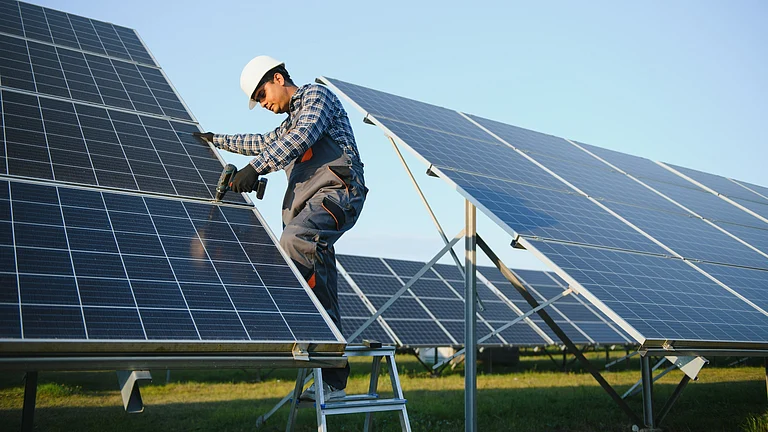India’s shining renewables story, spun around its sprawling solar parks, could be hurtling towards a tragic conclusion, amidst a deadly mélange of glass, aluminium, silicon and rare-earth elements, as its solar panels age and wither.
Conservative estimates show that by 2030, India could be saddled with 600,000 tonnes of waste even as its solar power capacity quadruples from the current 70 GW to 280 GW. By 2050, when India hopes to be churning out a mammoth 1,700 GW of solar power, the volume of waste could snowball to 19 million tonnes, enough to fill 3800 football fields. India’s green energy narrative, therefore, hangs by how effectively it manages its problem of plenty.
From 11 now, the number of solar parks in the country is expected to mushroom to 50 by 2026, with 39 new ones coming up rapidly across 26 states, primarily Rajasthan, Gujarat, Karnataka, Tamil Nadu and Andhra Pradesh, which already host the highest concentration of such parks. By 2050, these states could be grappling with two-thirds of all the solar scrap generated by the country.
Research warns that for every 1 GW of installed solar power, 50,000–250,000 tonnes of solar waste is generated over the lifecycle of panels, depending on how they are made and recycled. Experts believe that international best practices and stringent regulations, can potentially reduce waste by 70 to 80%. However, in India, the path to such progress is pockmarked with several challenges across the value chain, from design to disposal.
Solar Waste: Sources & Impact
However, where does all the waste come from? Explains Dr Akanksha Tyagi, Programme Lead at the Council on Energy, Environment and Water (CEEW), “waste is inherent to the entire solar manufacturing process, with material losses occurring at every stage.” This includes dysfunctional panels as well as waste from silicon production and module assembly.
Solar panels are an amalgam of valuable materials like silicon, silver and aluminium and toxic substances, such as cadmium and lead. To ensure that the hazardous elements do not end up in landfills prematurely, and to enable superior recycling and disposal practices, the Central Pollution Control Board (CPCB) urges solar players to store discarded panels for a certain specified period of time, in line with its guidelines. However, due to poor oversight, “we don’t know how well such guidelines are complied with,” says Dr Tyagi.
Compliance with the guidelines can contribute to building a circular economy, as by storing rather than discarding the parts, companies have the opportunity to recycle and repurpose them, thereby supporting resource conservation, a bedrock of sustainability. Conversely, violations can lead to soil and water contamination from the release of toxic substances. However, unless such guidelines take the form of inviolable regulations and are enforced strictly, they are likely to be of little benefit, as lack of compliance—much more than the deficiency of laws—has been the undoing in India across sectors.
Having said this, the absence of a watertight regulatory framework is doubtlessly an over-arching concern clouding the entire solar space, from design, manufacturing, installation and maintenance to recovery, recycling and disposal. For example, regulations explicitly binding solar power companies to quality benchmarks, could maximise the lifespan of solar systems and minimise replacements and waste generation.
The Challenge of Solar Waste Management
Acknowledging the importance of curbing solar waste for the future of the country’s renewable energy plans, the government has initiated several steps, such as bringing solar cell and module waste into the embrace of Electronic Waste (Management) Rules and prioritising solar PV recycling under the Renewable Energy Research and Technology Development (RE-RTD) Programme. However, industry insiders claim that while they are well-intended, these moves simply do not go far enough. For example, “e-waste management rules require producers to only collect and store solar waste, with no mandatory targets for recycling or proper disposal,” says Dr Tyagi, at CEEW. “Setting clear recycling targets could provide crucial direction for the industry to improve waste management practices and send a strong signal to private sector players to invest in recycling technologies," Dr Tyagi asserts.
However, a lack of regulations, as already mentioned, isn’t always the reason for the chaos in waste management. For instance, the Extended Producer Responsibility (EPR), which holds manufacturers accountable for their products throughout their lifecycle, including post-consumer use, is indeed an enforceable law, which, if strictly applied, could pretty much resolve India’s solar waste issue. However, owing to implementation barriers and half-hearted enforcement, this potent regulation is followed more in exception than in practice.
Waste Management: Shadows of Concern
Waste management in India’s under-regulated but booming renewable energy sector is essentially an informal activity. Not surprisingly, therefore, much of the solar scrap winds up in landfills or with informal waste workers who find ingenious ways to extract cash from the trash “Nearly 90% of the waste is currently processed by the informal sector with only a small fraction handled by formal recycling facilities,” says Nitin Gupta, CEO and Co-founder of Attero.”
However, without the necessary expertise and accountability, “these workers extract the aluminium frames of the modules for their high scrap value and toss the rest away— the toxic laminates, cadmium and solar cells, into landfills and backyards,” says Dr Tyagi. “To address this situation, India can draw inspiration from global models, such as the US-based PV module manufacturer, First Solar, which has established an integrated recycling unit.”
Solar Recycling: Good for Environment, Bad for Business
Recycling solar panels is a highly complex and energy-intensive process, demanding sophisticated machinery and infrastructure. “Solar waste is recycled in the informal sector primarily because of the prohibitively high logistics cost of transporting large solar sections from remote locations to recycling facilities, coupled with the high cost of the recycling machinery and infrastructure and the low resale value of the scrap,” says Gupta. “Even globally, solar waste recycling is not yet advanced enough to be offered free of charge.
The economics are stacked against the recycling business. In addition to the complexity of dismantling and shipping massive solar sections from remote locations, the total cost of managing solar waste is Rs 25,000-30,000 per tonne— enough to deter any business. The comparative cost for plastic waste is Rs 4000!
Adding to the challenge, most solar waste is low-value junk, like glass and laminates, making recovery an all-pain, no-gain business. “Investments will flow into the sector only when the industry matures, standards are effectively mandated, and compliance becomes universal and unavoidable,” adds Gupta.
Mandating producers to manage solar waste, including end-of-life panels, with binding regulations will force solar power producers to integrate waste management costs into their tariffs on a level playing field. This can take the viability factor out of the equation and lead to a durable solution.
Powered by gleaming solar parks, India’s green energy future is clearly finding a place in the sun, but unless the country finds ways to contain the waste from its fast-expanding solar infrastructure, it could find itself trading one environmental crisis for another. Ultimately, the success of India’s renewable energy transition hinges not only on expanding capacity but also on ensuring that its growth remains sustainable in the long term.































